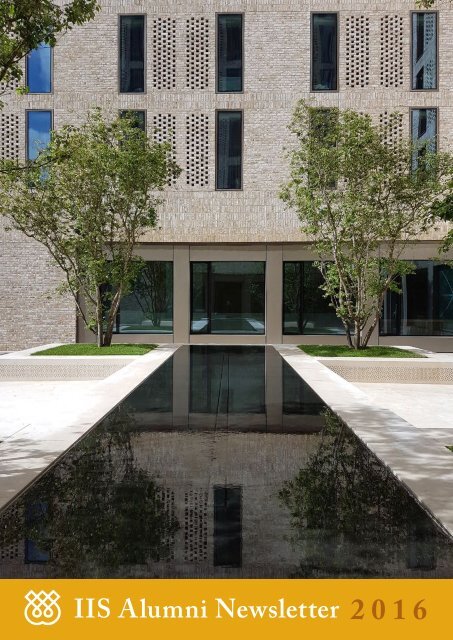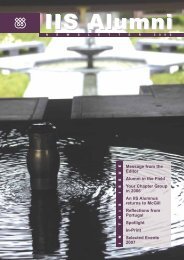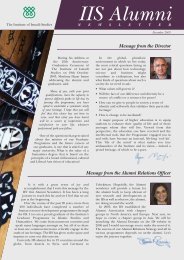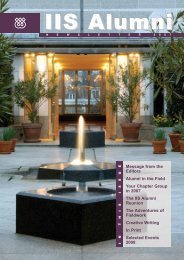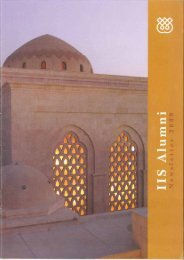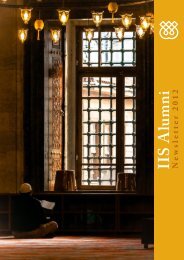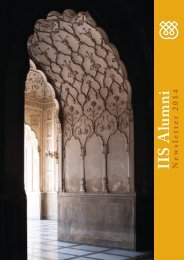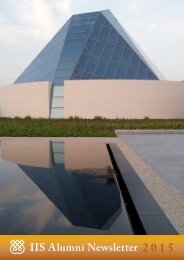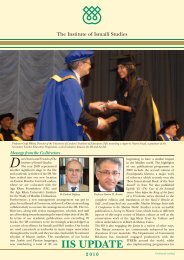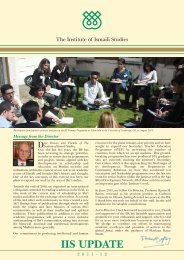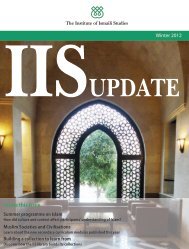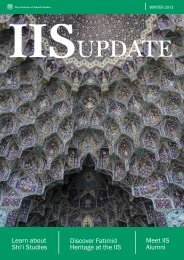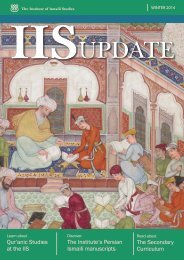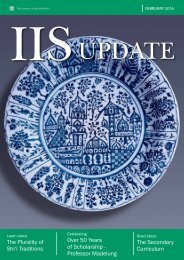IIS Alumni Booklet 2016
You also want an ePaper? Increase the reach of your titles
YUMPU automatically turns print PDFs into web optimized ePapers that Google loves.
<strong>IIS</strong> <strong>Alumni</strong> Newsletter <strong>2016</strong>
Messages<br />
Message from the Co-Director<br />
Dear <strong>IIS</strong> <strong>Alumni</strong>,<br />
I am delighted to inform you<br />
that preparations are under<br />
way for the <strong>IIS</strong> to move<br />
into its permanent home at<br />
King’s Cross, in 2018. In the<br />
meantime, as you may know,<br />
our student accommodation<br />
building has already been<br />
inaugurated and all our<br />
GPISH and STEP students<br />
are now housed there.<br />
Our move will be particularly exciting because it will<br />
coincide with two memorable celebrations: the first is of<br />
course the 60th anniversary, also known as the Diamond<br />
Jubilee, of His Highness the Aga Khan’s accession to<br />
the Imamat. We at the <strong>IIS</strong>, with other institutions, are<br />
considering ways to celebrate this momentous event.<br />
The second event will be the celebration of the 40th<br />
anniversary of the establishment of the <strong>IIS</strong>. Here again<br />
we will be looking at appropriate ways for celebrating<br />
- we hope that by building on our solid academic<br />
foundations the <strong>IIS</strong> will go from strength to strength in<br />
the fulfilment of its mission.<br />
In <strong>2016</strong>, we organised a seminar for a high profile<br />
delegation from the Government of Kyrgyzstan and<br />
their State Commission for Religious Affairs. The<br />
seminar provided an opportunity to exchange views on<br />
curriculum development, teacher training, pedagogy<br />
and the civilisational approach that the <strong>IIS</strong> follows in its<br />
academic programmes. As a result, the <strong>IIS</strong> is now one<br />
of the signatories to a Memorandum of Understanding<br />
with the Kyrgyz Republic.<br />
Last year, we also organised two major conferences.<br />
The first, “Fatimids and Umayyads: Competing<br />
Caliphates”, convened by Dr Miriam Ali-de-Unzaga,<br />
was co-sponsored by the <strong>IIS</strong> in collaboration with<br />
several other academic institutions. It aimed to compare<br />
these two contemporaneous dynasties in their contexts,<br />
looking at their interactions and affinities, while also<br />
discussing their conflicting claims to authority, all<br />
from an interdisciplinary perspective (historical, social,<br />
intellectual, economic, legal, theological, religious,<br />
cultural, technical, visual, and artistic). The second<br />
conference, “Intellectual Interactions in the Islamic<br />
World: The Ismaili Thread”, convened by Dr Orkhan<br />
Mir-Kasimov, focused on the intellectual interactions as<br />
well as the mutual influences that occurred between the<br />
Ismailis and other groups and movements within Islamic<br />
Civilisations. With such a comparative approach, the<br />
conference emphasised the intellectual diversity of<br />
the Islamic world along various perspectives, such as<br />
authority and law, philosophy, polemics, mystical and<br />
messianic trends or exegesis.<br />
We had our first Higher Education Review by the<br />
Quality Assurance Agency (QAA), examining every<br />
aspect of the Institute’s work that may have an<br />
impact on student experience. We met all of QAA’s<br />
expectations. Their report identified areas of good<br />
practice and made some recommendations. As a<br />
result, we have published an action plan and created<br />
a Quality Assurance Unit, which is now led by Diane<br />
Rainsbury. The QAA Review has confirmed that<br />
the <strong>IIS</strong> is able to operate at the highest standards<br />
within the UK Higher Education sector, delivering<br />
a high-quality experience to our students, as well<br />
as properly transmitting the complex and groundbreaking<br />
contents that the Institute’s research activity<br />
has developed over the past decades. This result is the<br />
outcome of the continued dedication of our staff and<br />
the commitment of our students.<br />
On a related note, I would like to mention that our two<br />
graduate programmes have recently been reviewed.<br />
The GPISH curriculum has been reviewed and<br />
strengthened by the Academic Steering Committee<br />
of the <strong>IIS</strong>. We are now seeking a partner from<br />
among British universities to obtain validation for<br />
our programmes. That will hopefully be the first step<br />
towards acquiring degree-awarding powers in the<br />
future. The STEP programme has also benefited from<br />
the feedback gathered from the teachers in the field.<br />
From September 2017, we shall offer a Postgraduate<br />
Diploma (PGDip) validated by University College<br />
London's Institute of Education (UCL-IOE), which<br />
will replace the current MTeach and we expect to<br />
further enhance the teacher training component<br />
of STEP. For the upcoming academic year, the MA<br />
Education (Muslim Societies and Civilisations) will<br />
continue to be delivered by our own faculty, and<br />
validated by UCL-IOE.<br />
Finally, I am delighted to announce that Salima<br />
Bhatia has been appointed as the Head of the<br />
Communications and Development Department. As<br />
many of you will know, Salima is an alumna of the<br />
<strong>IIS</strong>, and this brings the proportion of alumni who<br />
are currently members of our faculty and staff to a<br />
historic record of 40%.<br />
Let me wish you all a very auspicious, productive and<br />
creative Jubilee year.<br />
Dr Farhad Daftary<br />
2
I would like to thank all<br />
alumni for participating<br />
in the annual survey for<br />
<strong>2016</strong>. The results of the<br />
survey, in which 97%<br />
of alumni participated,<br />
are used to compile the<br />
<strong>Alumni</strong> Status Report<br />
which is submitted to the<br />
Institute’s Board. Some<br />
of the main points from<br />
the <strong>2016</strong> report are highlighted below:<br />
• Currently, the alumni body is comprised of<br />
551 graduates.<br />
• As part of the <strong>Alumni</strong> Internship Programme,<br />
a majority of recent GPISH graduates have<br />
been placed with various AKDN and Jamati<br />
institutions.<br />
• Twenty-nine alumni received various types of<br />
awards and grants, including fellowships or<br />
scholarships, and fifty-seven alumni presented<br />
papers at international conferences and<br />
published works.<br />
• Four research grants were awarded by the <strong>IIS</strong><br />
to alumni to present papers at conferences.<br />
• The vast majority of <strong>IIS</strong> graduates (91%) have<br />
contributed to Jamati and Imamat institutions,<br />
either in a professional or voluntary capacity.<br />
• Seventy-one alumni made contributions to<br />
Jamati/Imamat institutions through the Time<br />
and Knowledge Nazrana.<br />
• Twelve alumni were appointed to senior<br />
professional roles within Jamati and Imamat<br />
institutions or in external organisations.<br />
• In terms of voluntary contributions, ten<br />
alumni were appointed to senior positions in<br />
Jamati institutions and seven to positions in<br />
external organisations.<br />
• Although 35% of alumni were recruited from<br />
South Asia, only 19% reside there now. On<br />
the other hand, 35% of alumni are based in<br />
Europe, although only 5% were recruited<br />
from this region. Shifts in other regions are<br />
relatively minor.<br />
This year, we will be celebrating the Diamond<br />
Jubilee of His Highness the Aga Khan’s accession<br />
to the Imamat and also planning our move to the<br />
purpose-built academic building at King’s Cross<br />
designed by the Pritzker prize-winning architect<br />
Fumihiko Maki. In thanking you all for your<br />
ongoing support and participation, I hope that<br />
2017 will lead to further strengthening of the<br />
alumni body throughout the world and that the<br />
forthcoming Online <strong>Alumni</strong> Portal will encourage<br />
even greater engagement of alumni with the <strong>IIS</strong><br />
and each other. As always, I would like to take<br />
this opportunity to welcome new alumni and wish<br />
them the very best as they begin their careers.<br />
Congratulations!<br />
Shellina Karmali, <strong>Alumni</strong> Relations<br />
Coordinator<br />
The annual chapter group meetings were held in:<br />
i) Dubai (for the Asian Chapter Group) on The Ismailis<br />
of Central Asia: the Living Tradition of Nasir-i<br />
Khusraw. Dr Alice Hunsberger, Dr Daniel Beben, Dr<br />
Abdulmamad Iloliev, Dr Yahia Baiza and Shiraz Kabani<br />
delivered presentations;<br />
ii) London (for the European Chapter Group) where<br />
alumni came together for a one-day event, including a<br />
visit to the Wyndham Theatre to watch the Kite Runner;<br />
and<br />
iii) Oceanside, California (for the North American Chapter<br />
Group), on Re-presenting Islam and Muslims in these<br />
Challenging Times: Analyses and Strategies. Dr Ali<br />
Asani, Dr Alnoor Dhanani and Shiraz Kabani delivered<br />
presentations at the meeting.<br />
Asian Chapter Group<br />
European Chapter Group<br />
North American Chapter Group<br />
Chapter Groups<br />
3
Déjà Vu<br />
Shireen Khuwaja, STEP Class of 2013<br />
by encounters that were a testament to rising above one’s<br />
human condition and aspiring for knowledge.<br />
Cultural Connections<br />
"You can’t connect the dots looking forward; you can only connect<br />
them looking backwards. So you have to trust that the dots will<br />
somehow connect in your future."<br />
– Steve Jobs<br />
Have you ever had a moment when you encountered<br />
something from the past and realised that, in that<br />
moment, your own future had been foreshadowed?<br />
A few months ago, while cleaning my study, I came across<br />
an art piece I had created when I was in the ninth grade.<br />
At the time, it was a sophisticated symbol I had found in<br />
a magazine which I replicated. Upon seeing it this time,<br />
years later, I knew the symbol well . . . it was the logo<br />
of The Institute of Ismaili Studies (<strong>IIS</strong>). These dots had<br />
connected. I wondered what else I had been prepared for<br />
and what else is currently unfolding for my destiny.<br />
In my early childhood, I was exposed to a good measure<br />
of development work. My father’s senior executive<br />
position for a major finance firm had us travelling across<br />
remote areas of Pakistan, through villages nestled in the<br />
deep valleys of snow-covered mountains, where there<br />
were no proper roads. My mother, who came from a long<br />
line of scholars and educators, was a secondary school<br />
humanities and arts teacher, and she made it a point to<br />
connect with her students who had moved back to these<br />
villages from Karachi, where she had taught them. Thus,<br />
I was raised in and shaped by an environment inspired<br />
Even challenges seemed to have paved my path to a destiny I<br />
must have once designed for myself. Although I had studied<br />
at the best primary English schools in Pakistan called the<br />
Mama Parsi English School, when I came to the USA at<br />
age eleven, I lost my ability to articulate my thoughts with<br />
confidence. The shackles of my silence were soon broken<br />
when I enrolled in Public Speaking courses and began to<br />
win first prize medals across regional competitions within<br />
two years. This was my first experience of Western culture;<br />
through it, I learned the value of language – it meant<br />
having a voice.<br />
Twenty-five years later, as an Associate Programme Director<br />
of the 2015 Global Encounters camp in Mombasa, Kenya,<br />
I was asked to lead a project where each student, about<br />
sixty of them representing twenty-three countries, could<br />
receive personal coaching in developing a growth mindset.<br />
We found that the number one fear that this global Ismaili<br />
youth group faced was of public speaking – they lacked<br />
confidence in their own voice. For the past seven years as a<br />
STEP teacher, my task has been to teach the global Ismaili<br />
youth the kind of language through which they could<br />
articulate their identities as proud Shia Ismaili Muslims.<br />
My time spent at the <strong>IIS</strong> itself was a rebirth in many ways<br />
and, therefore, I truly consider the <strong>IIS</strong> to be my alma mater.<br />
At the <strong>IIS</strong>, I experienced the intermingling of cultures, which<br />
all of us in the STEP programme enjoyed and struggled<br />
through. This was an experience that no other time in<br />
4<br />
Group picture with the Minister of Education for Mombasa Honorable Tendai and team of AKA-Mombasa educators for Global Encounters camp.
my life can replicate. This is who “we” became<br />
when brought together from different lands: we<br />
all became people who enjoyed gatherings with<br />
food, even though the ingredients were different;<br />
we all craved celebrations with dances, even<br />
though the music and the moves were diverse;<br />
and we all cared when any one of us fell ill, even<br />
though medicinal concoctions were varied.<br />
It was also at the <strong>IIS</strong> that my deep desire to<br />
serve burgeoned. About ten years earlier, Dr<br />
Ali Asani had taught me my first fundamental<br />
lesson of service: to not expect it to be easy.<br />
Towards the end of my stay at the <strong>IIS</strong>, I was<br />
asked to go to Mozambique over the summer<br />
to train teachers there. When I discussed this<br />
matter with Dr Farouk Mitha, he taught me my<br />
second fundamental lesson of service: to really<br />
listen to the beneficiaries. Following this first<br />
trip, there have been two more to Mozambique,<br />
two to Mombasa, and one to the Congo. I<br />
have listened to the beneficiaries there, their<br />
joys, their challenges, and their aspirations,<br />
and I have shared the things I’ve learned with<br />
them. Previously, I had only witnessed my<br />
parents serving remote communities as a child;<br />
experiencing this for myself has been a joy I<br />
cannot express in words.<br />
In respect of youth development, I am a<br />
proponent of residential youth camps, and<br />
have enjoyed being involved with several youth<br />
camps based in the USA. One such experience<br />
this past summer allowed me the opportunity to<br />
apply the multiple languages I have learned over<br />
the past few years. As the Education Manager<br />
at the Aga Khan Academy (AKA) in Mombasa,<br />
I was asked to develop tangible educational<br />
experiences for Global Encounters participants.<br />
My International Baccalaureate (IB) certification<br />
in Teaching and Learning allowed me to<br />
develop processes with the AKA educators using<br />
the IB vocabulary that they worked with on a<br />
daily basis. The <strong>IIS</strong> had equipped me with the<br />
language of religious literacy, which allowed me<br />
to train our educators to articulate how service is<br />
a manifestation of religious ideals. My previous<br />
experience as Campus Director of a private<br />
education institution allowed me to collaborate<br />
with the teams across all facets of the operation.<br />
I had always wanted to see what all my combined<br />
experiences could produce and this experience<br />
was all the more special because it allowed me to<br />
build capacity and impact youth internationally.<br />
As I look back, I am convinced that Steve Jobs<br />
was right about trusting the dots to connect.<br />
Both intentionally and subconsciously, I have<br />
always felt inspired to work towards experiences<br />
that involve global, impactful and capacitybuilding<br />
opportunities. It is with this conviction<br />
that I look forward to the future with ambition<br />
and excitement. There is no doubt that I<br />
The <strong>IIS</strong> logo, chosen for a grade 8 art assignment and then submitted for a higher secondary art exhibit, while I<br />
was still in middle school. Twenty years later, the <strong>IIS</strong> became my alma mater.<br />
am a product of my parents’ and teachers’ inspiration, and<br />
that the greatest of my aspirations involves serving the larger<br />
human community. In fact, I wonder at the nature of the word<br />
“aspirations”: does it represent the future hopes one wishes to<br />
achieve or the visions of a transcendent nature one fulfils?<br />
Cultural Connections<br />
5
Reflections & Reviews<br />
Reflection on the Aga Khan Award for<br />
Architecture Winners’ Seminar (<strong>2016</strong>)<br />
Rami Gargour, STEP Class of 2014<br />
The acquisition of knowledge is potentially limitless in<br />
the sense that it has no contextual boundaries, whether in<br />
the learning space or among knowledge providers. I was<br />
fortunate to partake in the inspiring learning opportunity<br />
provided by the Aga Khan Award for Architecture (AKAA)<br />
Winners’ Seminar which took place on 5 November <strong>2016</strong><br />
in Dubai. It was an occasion that enabled the interaction<br />
of a multitude of stakeholders from the field of art and<br />
architecture – architects, art historians, artists, global AKDN<br />
representatives, Ismaili dignitaries and the six winners of the<br />
2014–<strong>2016</strong> Award cycle. The seminar comprised a panel<br />
of the six winners as well as the Master Jury and Steering<br />
Committee members of the <strong>2016</strong> AKAA. The panel<br />
discussion focused on issues and themes pertaining to the<br />
vision and criteria of this triennial cycle of the AKAA. The<br />
seminar served as a platform for enlightening discussions<br />
about human creativity, diversity, the built environment and<br />
quality of life, and how all of these go hand in hand when<br />
approaching architecture in its broadest sense.<br />
The AKAA was established in 1977 and is now in its<br />
thirteenth cycle. Every three years it awards projects that<br />
push the boundaries of excellence in architecture, planning<br />
practices, historic preservation and landscape architecture.<br />
The goal of the AKAA is to recognise and encourage<br />
building concepts that successfully meet the needs and<br />
aspirations of societies worldwide, primarily those in which<br />
Muslims have a significant presence. Nineteen projects were<br />
shortlisted for the 2014–<strong>2016</strong> cycle. From these, six winners<br />
were chosen and announced on 3 October <strong>2016</strong>. Those<br />
involved with these projects were recognised and honoured<br />
in a ceremony held at the Al Jahili Fort in Al Ain, UAE, on<br />
6 November <strong>2016</strong> in the presence of His Highness Prince<br />
Karim Aga Khan and His Highness Sheikh Mohammed bin<br />
Rashid Al Maktoum (Vice President and Prime Minister of<br />
the UAE and Ruler of Dubai).<br />
Attending the AKAA Winners’ Seminar opened my eyes<br />
to a wide array of perspectives which deem architecture a<br />
vital aspect of people’s daily lives. One major thing I learnt<br />
was that architecture is both concrete and visionary; it is the<br />
practical embodiment of people endeavouring to create a<br />
dignified life for themselves and for others. In other words,<br />
architecture is much more than mere buildings and designs; its<br />
effects have a direct bearing on people’s health, comfort and<br />
happiness. Speaking at the AKAA ceremony, His Highness<br />
the Aga Khan alluded to the ethical and moral dimensions of<br />
architecture and the need for us to use it responsibly as a tool<br />
to enhance well-being. He said:<br />
“The Holy Qur'an commands humankind to shape our earthly<br />
environment, as good stewards of the Divine Creation. In that<br />
spirit, in moments both of elation and disappointment, we hope<br />
that the Aga Khan Award for Architecture will always point<br />
towards an architecture of optimism and harmony, a powerful<br />
force in elevating the quality of human life.”<br />
A key point to take away here is that architecture is not an end,<br />
but rather a means to holistically attain both sustainability<br />
and human dignity.<br />
Overall, the insights I gained from the AKAA and<br />
architecture in general are of great value to me as a teacher,<br />
as the principles can be utilised in the teaching and learning<br />
processes in the classroom environment.<br />
6
Review of the Play The Kite Runner<br />
Karim Mitha, GPISH Class of 2011<br />
Entering the auditorium of the Wyndham’s Theatre<br />
in London to watch Matthew Spangler’s adaptation of<br />
Khaled Hosseini’s novel The Kite Runner one felt instantly<br />
transported to the exotic environs of Kabul, Afghanistan.<br />
The audience was welcomed by the rhythmic beats of the<br />
tabla (a South Asian percussion instrument similar to a drum)<br />
– “Thaka tha . . . Thikka Tha. Tha thikka tha. Thikka tha”. The<br />
set’s background resembled the City of London’s skyline,<br />
which anchored the audience, and the story, through the<br />
play’s shifting locales. Through the clever use of set design<br />
and lighting, the audience was transported from the story’s<br />
initial beginnings in Kabul, to the protagonist’s coming-ofage<br />
in America, and to the story’s climax and denouement<br />
in Pakistan. Accompanying these set changes were the shifts<br />
in the tempo of the tabla, and the static background, despite<br />
its modifications to resemble different cityscapes, served as<br />
a reminder that we, the audience, were witnessing this story<br />
through an Occidental lens.<br />
The Kite Runner, on limited run in London’s West End, was the<br />
event of choice for The Institute of Ismaili Studies’ reunion<br />
of the European Chapter Group. At first thought, this play<br />
may have seemed an odd choice, with no apparent link to<br />
theology or Ismaili culture. Yet, the themes of the play have<br />
great relevance for the Ismaili community as its depiction<br />
of the treatment of the Hazara population in Afghanistan,<br />
the challenges of migration and diaspora, of integration<br />
into new cultural climes, and the notion of “home” amidst<br />
Islamisation and immigration, all echo the experience of the<br />
Ismaili collective through its history as a minority community.<br />
Indeed, for the European Chapter Group, the symbolism of<br />
the set design was quite a propos, given that London itself was<br />
home to the reunion of the alumni of different ethnicities,<br />
languages and ages.<br />
This play was adapted independently of the film, and the<br />
plurality of media in which the story has been told indicates<br />
it is of great interest: it brings to the forefront a population<br />
that is often buried deep in the recesses of the public’s<br />
consciousness and corrects previous media portrayals of that<br />
community as “backward” or “uncivilised”. The Kite Runner<br />
narrates the changes that have taken place in Afghanistan<br />
over the last forty years, as chronicled through the lens of<br />
friendship between two boys, and shows how circumstances<br />
beyond an individual’s control can radically alter the nature<br />
of personal relationships.<br />
The story is that of Amir (played by Ben Turner), a<br />
Pashtun, whose friendship with Hassan (played by Andrei<br />
Costin), a young Hazara, forms the crux of the narrative.<br />
The two are bonded by circumstance, with Hassan being<br />
the family servant of Amir and his Baba (played by Emilio<br />
Doorgasingh), as well as in ways the young boys cannot<br />
fathom. Amir, an introspective boy, longs for the attention<br />
his father bestows on Hassan. However, Baba has no time for<br />
Amir’s stories and wishes Amir would be more like Hassan.<br />
The social relationship of master–servant is flipped, as it is<br />
often Hassan who is the dominant, outgoing one, coming, for<br />
instance, to the rescue of Amir, who is bullied by Assef (played<br />
by Nicholas Karimi) and his gang. Amir tries to subvert this<br />
relationship by making<br />
fun of Hassan’s illiteracy,<br />
but nevertheless relies<br />
on him in the famed kite<br />
running competition. It<br />
is at this point that<br />
the audience is fully<br />
immersed in the story,<br />
being figuratively drawn<br />
in through the deft<br />
movements of the actors<br />
portraying kite flying, as well as when the “friendship” between<br />
Hassan and Amir is fractured.<br />
The events following the competition demarcate the end of<br />
innocence for Amir and Hassan, and also for Afghanistan.<br />
The shattering of the boys’ relationship mirrors the larger<br />
devastation taking place in the country. The play, much like a<br />
Bollywood film, then takes an abrupt turn in setting and tone<br />
as it focuses on Amir’s coming of age and possible redemption<br />
in America.<br />
The play addresses many issues relevant to contemporary<br />
multicultural audiences, including ethnic enclaves, challenges<br />
of spousal selection amongst migrant communities, and<br />
increasing Islamisation. For instance, in the latter half of<br />
the play, the comedic circumstances involving Amir’s ethnic<br />
courting are juxtaposed with his own experience of fear and<br />
horror at the atrocities of the Taliban. Additionally, Assef,<br />
Amir’s former bully, is shown to be radically Islamised and<br />
thus acts as a physical manifestation of hyper-religiosity in<br />
how he outwardly demonstrates piety and puritanism, which<br />
may in fact cover up his innate private deviances and, perhaps,<br />
implicit self-hate.<br />
Because Amir’s coming-of-age drives the narrative, he becomes<br />
a vehicle for the audience to experience growth from naiveté<br />
to maturity. It is through this approach, of slowly gaining an<br />
awareness of the broader social world through age and time,<br />
that the play is able to gloss over historical details and cultural<br />
nuances and is thus a reminder of its intended Occidental<br />
audience. Ironically, patriarchal and misogynistic themes are<br />
replicated in the production of the play as it is adult actors<br />
who portray children, and the actors’ switching between the<br />
adult and child versions of their characters is, at times, jarring.<br />
Secondary characters are given little character development,<br />
and the development of female characters, including that<br />
of Amir’s wife Soraya (played by Lisa Zahra), is often nonexistent;<br />
they seem to merely exist as instruments to further<br />
the narrative.<br />
Despite these flaws, however, The Kite Runner, by focusing on a<br />
personal story to comment on larger social issues, helps to put<br />
a face on a population that is often portrayed as the “Other” in<br />
Western discourse and helps to show the interconnectedness of<br />
people and the importance of giving refugees and migrants a<br />
new chance at life. The full house at the matinee performance<br />
demonstrated that there is an audience for these stories. Whilst<br />
the multi-cultural and multi-religious background of the actors<br />
in the story is a testament to the positive aspects of pluralism,<br />
the next step would be to ensure greater authenticity through<br />
more ethnic representation in the arts, so that that ethnic<br />
people are able to tell their own stories in their own voice.<br />
Reflections & Reviews<br />
7
Reflections & Reviews<br />
8<br />
A Timely Exhibit Of Syria’s<br />
Living History At The Aga<br />
Khan Museum<br />
Sahir Dewji, GPISH Class of 2011<br />
The role of Museums in<br />
representing Heritage and Plural<br />
Identities<br />
Museums are understood to serve as<br />
“engines of social transformation” 1 imbued<br />
with the responsibility to better inform,<br />
through their collections, the dynamism of<br />
cultural interchange and past civilizations<br />
that have been the hallmark of human<br />
life. It is in this context that the Aga Khan<br />
Museum serves as a locus of human<br />
evolvement in all areas of life whether they<br />
are preserved in material or immaterial<br />
elements, with particular attention to the<br />
historiography and development of Muslim<br />
societies. As Prince Amyn Aga Khan has<br />
aptly noted, “This is a Museum of Islamic<br />
Arts with a broad definition of all that the arts include,<br />
and we present these arts as best we can within their full<br />
cultural context”; at the heart of the Aga Khan Museum’s<br />
activities is a spirit of inspiration and enlightenment,<br />
“helping visitors from around the world to rediscover the<br />
common symbols that unite us all across the globe, across all<br />
civilisations, across time.” 2 Demonstrating the diversity of<br />
lived-lives and societies is a key feature of representing the<br />
heritage of places and peoples. Heritage, as such, is more<br />
than just an artifact; it is “a constitutive cultural process”<br />
and a discursive practice that emphasizes the movement<br />
of people, meanings, memories and experiences. 3 Simply<br />
put, heritage is about the activity of “doing” and “making”,<br />
which is brought to the fore through the newly installed<br />
exhibition at the Aga Khan Museum, showcasing the<br />
cultural diversity of what constitutes Syria while unveiling<br />
to the audiences the pluralizing pasts that have influenced<br />
the rich tapestry of Syria’s socio-cultural history.<br />
Exhibition of Syrian Art and Antiquities: “Syria, A<br />
Living History”<br />
This exhibit does not simply aim to replicate Syria’s history<br />
and diverse character, but seeks to transform how people<br />
think of and perceive the Syria we have come to know alltoo-well<br />
through the media, concerning stories of endless<br />
violent conflict and flight for refuge. The exhibition has come<br />
together under the patronage of UNESCO and involves<br />
a collaboration of seven international institutions, whose<br />
desire it is to share the remarkable story of Syria. Visitors<br />
are offered a panoptic view of Syria’s 5,000-year history<br />
through a collection of sculptures, ceramics, photographs<br />
and other artistic pieces from numerous traditions, dating<br />
from the fourth millennium BCE to the present. Although<br />
it is a compact exhibition with around 50 or so objects,<br />
there remains a sense of depth captured in the objects<br />
themselves through a well thought out course. The artifacts<br />
are organized into 6 themes that can be traced across the<br />
many periods and cultures of Syria’s history. They include:<br />
Divinity, Humans and Beasts, Religion and State, Conceptions of<br />
Home, Affinities and Vagaries of Time. “Thus, the artifacts<br />
presented under these headings,” writes one of the exhibit’s<br />
Photo by Janet Kimber © The Aga Khan Museum<br />
curators, “are meant to underscore the universality of their<br />
shapes, functions, and intents as well as the particularities of<br />
their Syrian environment, inspiration, and sensibilities and<br />
their artistic contribution to world culture.” 4<br />
The curators, Filiz Çakır Phillip and Nasser Rabbat, have also<br />
chosen some works from contemporary Syrian artists. Near<br />
the exhibition’s end, for example, is a digital reproduction<br />
of Tammam Azzam’s Freedom Graffiti – a photographic work<br />
that superimposes Gustav Klimt’s iconic work, The Kiss<br />
(1907-1908), over the walls of a war-torn building in Syria,<br />
juxtaposing Syria’s experience of beauty and devastation.<br />
The position of this wall image is telling as it faces the only<br />
window in the upper gallery with light shining in from the<br />
museum’s entrance; perhaps this is a deliberate choice that<br />
resonates with the exhibit’s motif of hope. In keeping with<br />
the museum’s inclination to interactive art, visitors are able<br />
to write a message on a blank card and clip it to the wall<br />
image, further amplifying the message of cultural continuity,<br />
diversity and humanness. Another interactive station allows<br />
the visitor to explore the languages of Syria first hand, by<br />
uncovering the different names of “Syria” in Cuneiform,<br />
Greek, Syrian and Arabic, attesting to Syria’s polyglot nature<br />
and reminding us of its importance as the world’s “cradle of<br />
civilization”. There is even a 3D virtual reality experience<br />
where viewers can step inside a 17th-century Aleppo room<br />
with the use of a computer tablet.<br />
Each visitor, without doubt, will have his or her favourite piece<br />
of art. As for me, I am partial to the small carved figurine,<br />
Eye idol circa, 3200 BCE, excavated at the ancient city of Tell<br />
Brak in northeastern Syria. Such figurines were presented<br />
at temples as offerings for spiritual protection. Prominent<br />
British archeologist Sir Max Edgar Lucien Mallowan (d.<br />
1978) coined the name “eye idols” for these objects during<br />
excavations at Tell Brak in Syria, where hundreds of small<br />
anthropomorphic plaques with huge eyes were found in<br />
a richly decorated building, known as the “Eye Temple”. 5<br />
Although small in size, this figurine is packed with symbolism<br />
that seems to bear some relation to the popular talismans<br />
of the contemporary Mediterranean region, commonly
eferred to as “Nazar” created to protect<br />
oneself against the evil eye. Several<br />
charms bearing the eye-like symbol have<br />
become a permanent heritage across<br />
countries like Greece, Syria, Turkey and<br />
others who all claim rightful ownership to<br />
the tradition. It goes without saying that<br />
Syria certainly served as a crossroads of<br />
culture, language and faith.<br />
Finally, the exhibit comes full circle with<br />
Elias Zayat’s 12-foot mural (acrylic on<br />
canvas) that hangs at the entrance of<br />
the exhibit. The piece is entitled Deluge:<br />
The Gods Abandon Palmyra and captures<br />
the thrust of the exhibit’s aspiration.<br />
The mural is a depiction of the deluge,<br />
which Zayat chose to situate in Palmyra<br />
as a way to link Syria’s past, present and<br />
future. The painting portrays the diverse species and<br />
ethnic groups united in their resilience, in their darkest<br />
of hours, with a promising optimism for a new beginning.<br />
The tale of the deluge was first illustrated in the most<br />
famous Mesopotamian myth, The Epic of Gilgamesh. On<br />
his journey, Gilgamesh meets the sole survivor of a great<br />
flood that destroyed the world. 6 Later on, with the rise of<br />
monotheistic communities, the tale would be retold with<br />
a new hero, the Prophet Noah. Steeped in this mural is<br />
the flood narrative that carries with it a shared history<br />
of civilizations. The significance of this narrative is the<br />
universal desire for the triumph of good over evil. It is also<br />
connected to broader questions that still haunt humans<br />
today such as, the origin of life, the relationship between<br />
Photo by Janet Kimber © The Aga Khan Museum<br />
nature and society, and the relationship between humanity<br />
and the Divine.<br />
The exhibit provides the visitor with a redefined sense<br />
of lived history and a Syria of interactions, confluences,<br />
and creativity. Perhaps the only missed opportunity in<br />
this exhibition is the accessibility to non-English speaking<br />
audiences who would have benefited from an audio guide<br />
in different languages. 7 Nevertheless, there is a poignant<br />
awareness of Syria’s arts and culture which stands as<br />
testimony of the human contribution to civilizations, both<br />
past and present, and the continuous desire to restore faith<br />
in humanity.<br />
Reflections & Reviews<br />
Photo by Janet Kimber © The Aga Khan Museum<br />
1 Tony Bennet, “Exhibition, Difference and the Logic of Culture”, Museum Frictions, ed., Ivan Karp & Corinne A. Kratz (Durham, NC: Duke University Press, 2006), p. 57.<br />
2 Prince Amyn Aga Khan, “Speech at the Opening of the Aga Khan Museum”,The Ismaili, 12 September 2014.<br />
Available at https://www.theismaili.org/speech-prince-amyn-aga-khan-opening-ceremony-aga-khan-museum-toronto<br />
3 Laurajane Smith, Uses of Heritage (Abingdon: Routledge, 2006), p. 3.<br />
4 Nasser Rabbat, “Syria: Where Cultures Met”, in Syria A Living History Companion Book, ed., Diane Watson (Toronto: The Aga Khan Museum, <strong>2016</strong>), p. 10.<br />
5 Filiz Çakır Phillip and Nasser Rabbat, “Exhibition Highlights”, in Syria A Living History Companion Book, pp. 14-15.<br />
See also Françoise Demange, Les Antiquités orientales (Paris: Réunion des Musées nationaux, 1994).<br />
6 Archaeologists have found evidence suggesting that a catastrophic flood did devastate Mesopotamia somewhere about 4,900 years ago<br />
7 I am aware of one incident where a Syrian family (recent refugee arrival) came with their sponsored family to reminisce about the glory and beauty of their homeland being showcased<br />
at the museum. Unfortunately, the Syrian individuals had no English skills and their host family did not speak Arabic leaving these visitors with only their eyes to see the artifacts but not<br />
understanding their significance in the exhibit.<br />
9
Reflections & Reviews<br />
10<br />
Journey into Ruptures & Discontinuities:<br />
A Fieldtrip to Delhi<br />
Nisha Keshwani, GPISH Class of 2010<br />
For a decade, the Aga Khan Trust for Culture (AKTC)<br />
has had a presence in Delhi’s Nizamuddin heritage<br />
precinct. Its work there has encompassed the preservation<br />
of Humayun’s Tomb, the Sunder Nursery (the gardens<br />
adjacent to Humayun’s Tomb) and over 45 monuments<br />
in the Nizamuddin Basti area, an area containing one of<br />
the densest ensembles of medieval monuments in India.<br />
In 2015, thanks in part to the AKTC’s findings, UNESCO<br />
recognised that the areas around Humayun’s Tomb were<br />
of outstanding universal value, and agreed to considerably<br />
expand the boundaries of that World Heritage site. The<br />
aim of the AKTC is to sympathetically restore these sites,<br />
and in this vein it has employed master craftsmen who use<br />
traditional tools, materials and building techniques that are<br />
in keeping with those utilised at the time these structures<br />
were first constructed. Additionally, the AKTC seeks to<br />
enhance the quality of life of the local resident communities,<br />
so it has worked closely with them to improve such things<br />
as healthcare, education, sanitation, housing and waste<br />
collection, and assisted them with urban development,<br />
cultural revival and, lately, madrasa improvement. 1<br />
With the AKTC’s conservation and developmental<br />
initiatives in Delhi a focal point, ITREB India organized<br />
a fieldtrip for its academic staff, as well as for the STEP<br />
teachers and its programme staff in early December <strong>2016</strong>.<br />
This trip was meant to expose the group to the various<br />
cultural encounters that had occurred during India’s history,<br />
through visits to select architectural monuments at Delhi,<br />
Agra and Fatehpur Sikri. It aimed to explore the material<br />
culture of the five Muslim dynasties which ruled over India<br />
sequentially: the first four, the Mamluk dynasty (1206–<br />
1290), the Khilji dynasty (1290–1320), the Tughlaq dynasty<br />
(1320–1414) and the Sayyid dynasty (1414–1451), were of<br />
Turkic origin, and the fifth, the Lodi dynasty (1451–1526),<br />
was of Afghan origin. The Mughal dynasty (1526–1540;<br />
and 1555–1857) was also a major focus of the fieldtrip. The<br />
discussions that these dynasties’ architectural monuments<br />
inspired in the group cut across sectarian and political lines,<br />
but also touched on the subject of identity – in particular,<br />
the past’s construction of Islam as a homogenous category,<br />
and its impact on the present.<br />
On a chilly morning, our group arrived at the first<br />
destination of our three-day journey: the Qutub Minar<br />
complex. Our guide, Dr Jaybir Singh, besides being a tour<br />
guide, was a practitioner of Ayurveda, an ancient system of<br />
medicine, and had a passion for astrology. He told us that<br />
the complex is a World Heritage site, and consists of the<br />
striking conical tower (which stands at 73 meters and took<br />
several years to construct) and the monuments surrounding<br />
it. He stated boldly and with the confidence of an “expert”<br />
that the minaret is perceived today as a symbol of victory<br />
of the Muslim dynasty over the last Hindu ruler of Delhi,<br />
Prithviraj Chauhan, especially, he pointed out, because<br />
the Muslim dynasty replaced old structures with new<br />
architectural monuments. This interpretation of “Muslim<br />
rule” as having replaced “Hindu rule”, as embodied<br />
through changes to the various monuments, unfortunately<br />
completely ignores the many cultural exchanges that each of<br />
these groups engaged in. Yet it is currently a widely accepted<br />
view in India. As we proceeded, the guide also seemed to<br />
subscribe to the concept of “Muslim rule” as undifferentiated,<br />
failing to acknowledge the unique approaches to leadership<br />
employed by the individual Muslim dynasties.<br />
This latter view held by the tour guide, unfortunately, is also<br />
common among orientalists and nationalist historians alike;<br />
Muslim rule in India is seen not just as oppressive, but as<br />
monolithic. 2 Dominique-Sila Khan has demonstrated this;<br />
Khan says the tendency to project Islam as one uniform<br />
religion when confronted with the “other” 3 is a consequence<br />
of the colonial imagination, and is as prominent in other<br />
religions as it is within Islam in South Asia. Either to project<br />
uniformity to create a sense solidarity or to project a high<br />
number of followers in response to the “race for numbers”<br />
in order to improve their positions in India, Muslims<br />
themselves also projected Islam as a uniform religion. Also,<br />
during British colonial rule, the colonial authorities justified<br />
their own civilizing mission by projecting their immediate<br />
predecessors—the Muslims—as an undifferentiated mass<br />
of people. 4 But this unfortunate categorisation conceals the<br />
complex and fascinating ways in which differences were<br />
negotiated throughout history.<br />
There has also been a tendency to introduce an artificial<br />
civilizational divide between India’s “Hindu” and “Muslim”<br />
periods. Richard Eaton calls this into question, and examines<br />
how these transitions in history should be viewed and<br />
accounted for when not seen through the lens of a linear<br />
history of conquests. 5 Recent scholarship has sought to write<br />
more connected histories by focusing on the circulation of<br />
texts, things, people and ideas. In Culture of Encounters: Sanskrit<br />
at the Mughal Court, for instance, Audrey Truschke highlights<br />
the robust interactions between Sanskrit scholars and Persian<br />
intellectuals in the Mughal court, especially during Akbar’s<br />
reign, when he tried to merge aesthetic conventions and<br />
religious convictions from both literary imaginations to<br />
establish a distinctly Indian polity. 6<br />
Cultural encounters have taken the forms of wars, conquests,<br />
submission, exploitation, trade, diplomacy and even religious<br />
missions. But to say, as it has been said, that these resulted in<br />
the cultural traits of the dominant group being imposed upon<br />
the less dominant group is not only static but ethnocentric. 7<br />
Today, the myth of India’s medieval Muslim villains 8 who<br />
dominated and imposed their will on the cultural, political<br />
and social landscape of their times is prevalent. This myth<br />
needs to be dispelled, and the new approaches within the<br />
theories of cultural encounters try to do so by focusing on<br />
the dynamic interaction between “the sender” and “the<br />
receiver” of cultural input. It is also important to study the<br />
process of change that influenced the dominant culture. I<br />
asked: can these theoretical strands help us to articulate the<br />
exchanges between cultures in a way that lends freshness<br />
to the contemporary interfaith dialogue in India? In other<br />
words, why can’t the Indic ornamentation in the architecture<br />
built by a Muslim ruler be considered a sign of healthy<br />
exchange rather than a symbol of power and dominance<br />
by the Muslims? One possible response to this question in<br />
today’s time is offered by the AKTC’s work.<br />
If interpreted using earlier theories of cultural encounters,
Muslim culture then and<br />
the Hindu culture now can<br />
be seen as dominant and<br />
affecting less influential<br />
cultures. But a more<br />
dynamic view accepts that<br />
as much as the Muslim<br />
culture affected the local<br />
Indic culture, the reverse<br />
was equally true. Akbar’s<br />
short-lived residence at<br />
Fatehpur Sikri brought<br />
together the regional<br />
architectural traditions of<br />
India which had absorbed<br />
the Indian forms earlier,<br />
and clad them in red<br />
sandstone. 9 The syncretism<br />
of different regional Indian,<br />
Central Asian and Persian<br />
styles signalled that these<br />
buildings could be attractive<br />
to all of the emperor’s subjects, regardless of their religious<br />
identity, ethnicity or geographical origin. 10 Akbar strove for<br />
a reconciliation between his Hindu and Muslim subjects,<br />
especially in intellectual and religious spheres; built his<br />
relations with the Safawids, Uzbeks and Ottomans; and also<br />
sent an envoy to the pope and King Phillip II of Spain. 11<br />
Another Mughal ruler, Aurangzeb, on the other hand,<br />
who was a strict orthodox Muslim, broke with the liberal<br />
traditions of his predecessors. The exchange of cultural<br />
elements between regional traditions and the Timurid<br />
architectural heritage the Mughal’s brought with them,<br />
along with shifts within the dynasties (as given in the<br />
example of Aurangzeb), if viewed from the new theories<br />
of cultural encounters, prevents one from seeing the shift in<br />
mere chronological fashion and thus as mere expressions of<br />
power from one dominant culture to the lesser one.<br />
More importantly, the AKTC’s work can be seen in an<br />
inclusive light, if understood from this framework of<br />
dynamic exchanges of cultural inputs. The conservation of<br />
the Baoli and Chausath Khambha are just two examples.<br />
The former is the fourteenth century stepwell which was<br />
considered holy by millions. It was desilted 80 feet below<br />
ground level for the first time in centuries and its broken<br />
parts were restored. The latter is the tomb of Mirza Aziz<br />
Koka, the cousin of Akbar, with twenty-five domed chambers<br />
supported on sixty-four marble columns. Investment in these<br />
two monuments, which may be considered of less functional<br />
value than some others but are certainly important culturally,<br />
could easily have been neglected for fear of causing a “drain<br />
on fragile economies” 12 in Basti. But restoring these sites<br />
allows or even creates a “cultural space” for further exchanges<br />
between various communities and for finding new grounds to<br />
develop the local community itself to expand its potentialities<br />
in new forms. 13<br />
After witnessing the painstaking efforts by the AKTC at<br />
Humayun’s tomb, I wondered if all the monuments we visited<br />
on our fieldtrip could be maintained equally well under a<br />
public–private partnership similar to the one between the<br />
government of India and the AKTC. Instead of the myth of<br />
the “medieval Muslim villains” taking political prominence,<br />
I walked away hoping that the story of Muslims in India will<br />
be rewritten with trust by well-meaning protagonists. This<br />
not only will enable many successful partnerships that will be<br />
of the benefit of the monuments in ruinous state but will also<br />
create more possibilities of exchange and partnership, not in<br />
favour of one or the other culture but for a seamless dialogue,<br />
called “encounter”.<br />
Reflections & Reviews<br />
1 The information within this paragraph was taken from the “Nizamuddin Urban Renewal Annual Report 2014”.<br />
http://annualreport2015.nizamuddinrenewal.org/annualreports-details/2015/136/executive-summary.php.<br />
2 Nandini Ramachandran, “Crossing Paths: Histories that Challenge the Reductionist Popular Understanding of Islam in India”, Caravan Magazine 9, no. 2 (February 2017), pp. 78–85.<br />
http://www.caravanmagazine.in/reviews-essays/islam-histories-challenge-understanding-india.<br />
3 Dominique-Sila Khan, “Being One and Many among the Others: Muslim Diversity in the Context of South Asian Pluralism”, in Diversity and Pluralism in Islam: Historical and<br />
Contemporary Discourses amongst Muslims, ed. Zulfiqar Hirji (London, I.B.Tauris, 2010), pp. 43–60.<br />
4 Ramachandran, “Crossing Paths”, p. 85.<br />
5 Richard Eaton and Phillip Wagoner, Power, Memory, Architecture: Contested Sites on the Deccan Plateau, 1300–1600 (Oxford, Oxford University Press, 2014)<br />
6 In Ramachandran, p. 83.<br />
7 See “CEPS – Cultural Encounters in Pre-Modern Societies”. http://www.en.cgs.aau.dk/research/research-groups/ceps.<br />
8 Audrey Truschke, “It is High Time We Discarded the Pernicious Myth of India’s Medieval Muslim Villains”.<br />
https://thewire.in/18919/high-time-discarded-pernicious-myth-indias-medieval-muslim-villains/.<br />
9 Ebba Koch, Mughal Architecture: An Outline of Its History and Development (1526–1858) (Delhi, Primus Books, 2014), p. 5.<br />
10 Koch, Mughal Architecture, p. 5.<br />
11 Koch, Mughal Architecture, p. 5.<br />
12 As noted in a keynote address by Mawlana Hazar Imam delivered at Hangzhou International Congress on 15 May 2013,<br />
available at: http://www.akdn.org/speech/his-highness-aga-khan/unesco-conference-china.<br />
13 https://www.bu.edu/wcp/Papers/Cult/CultGevo.htm.<br />
11
“Walking up the stairs to the Centre for Early Childhood<br />
Development, we were welcomed by the little children’s<br />
smiles and laughter. During the tour, we explored the<br />
different kinds of learning materials that toddlers use<br />
to learn about sounds, shapes and colours. We were<br />
impressed with the comprehensive schedule for toddlers,<br />
and how it supports parents who are also working towards<br />
their careers. The design and layout of the centre enables<br />
toddlers to have a safe space and conducive environment to<br />
learn and leverage early childhood skills. Waving goodbye<br />
to them, left a piece of our heart in the beautiful gardens of<br />
AKU.”<br />
– Shehzeen Sunderji, STEP Class of 2013<br />
Alykhan Dhanani, STEP Class of 2015<br />
Reflections & Reviews<br />
I had the opportunity to visit and observe the<br />
operation of the Centre for Early Childhood<br />
Development (CECD) located on the premises<br />
of the Aga Khan University during my visit to<br />
Karachi for the STEP–CPD workshop. The remit<br />
of the CECD is to provide young children with a<br />
good start in life by making learning enjoyable and<br />
promoting in them a strong sense of identity and<br />
self-worth. Additionally, it seeks to enable students<br />
to communicate effectively, be tolerant of others<br />
and develop a sense of community. It prepares<br />
them to become ethical and responsible human<br />
beings during this early stage of life.<br />
As soon as the children were dropped off at the<br />
centre, they began activities that allowed them to learn<br />
different skills together, thereby forming a community of<br />
learners. I recognised this strategy from my own classes<br />
at the secondary level where I would put my students<br />
to work in groups, thereby forming a zone of proximal<br />
development from which I would be able to determine<br />
what a student can do with the support of his or her peers<br />
and otherwise. This strategy is based on an educational<br />
theory by Lev Vygotsky (1896–1934). Vygotsky’s theory<br />
talks about collaborative practice in the educational<br />
context, and it concentrates on peers building each other’s<br />
skills through collaborative practice and scaffolding.<br />
What I found the most interesting was that the young<br />
children were always kept on the go at the CECD, with care<br />
taken to give every child equal attention. They played games<br />
and participated in learning tasks such as listening, clay or<br />
play-dough moulding, reading and speaking. This interested<br />
me the most because as a teacher-practitioner my teaching<br />
philosophy is framed by the concept of active learning,<br />
where the students take part in the lesson through activities<br />
and then reflect on these activities to make meta-cognitive<br />
connections to real-life situations or to their present day<br />
environment.<br />
The children were allowed “nap time”<br />
during the late afternoon. This period<br />
of rest helped to restore their energy and<br />
allowed them to recover from the activities<br />
in which they had participated throughout<br />
the day. Linking this concept to my own<br />
classroom teaching, I realised that giving<br />
my students a break would revive them and<br />
allow them to refocus their attention on<br />
classroom activities.<br />
12<br />
Overall, my visit to the CECD was a<br />
great opportunity for me as a teacher to<br />
learn about early childhood education.<br />
It also made me reflect upon the various<br />
educational theories that are in practice,<br />
and make connections between the teaching<br />
and learning processes in the early years of<br />
education and secondary levels.
Abdulmamad, I. (<strong>2016</strong>a). ‘The Ismailis of Badakhshan’,<br />
Munzur Ethnographic Journal, 40, 3–9.<br />
(<strong>2016</strong>b). The concept of wilayah in Mubarak-i Wakhani’s<br />
Chehel dunya: A traditional Ismaili-Sufi perspective on<br />
the origins of divine guidance. Presentation at the Institute<br />
of Ismaili Studies, ‘Intellectual Interactions in the Islamic<br />
World: The Ismaili Thread Conference’, London, UK.<br />
Ali, R. (<strong>2016</strong>). ‘Stretching the boundaries of medical<br />
education: A case of medical college embracing humanities<br />
and social sciences in medical education’ (co-authors:<br />
Ghias, K., Khan, K. S., Azfar, S., & Ahmed, R.), Pakistan<br />
Journal of Medical Sciences, 32(4), 911–916. http://dx.doi.<br />
org/10.12669/pjms.324.10237<br />
Charania, S. Y. (<strong>2016</strong>a). ‘Encouraging student reflection: A<br />
reflective study of non reflective students in India’, Journal<br />
of Teaching and Education, 5(2), 183–192.<br />
(<strong>2016</strong>b). Encouraging student reflection: A reflective study<br />
of non reflective students in India. Presentation at the<br />
Annual Multidisciplinary Conference of the International<br />
Journal of Arts & Sciences (IJAS), Boston, USA.<br />
Dad, A. A. (<strong>2016</strong>a). ‘Boundaries and identities: The case of<br />
Gilgit-Baltistan’, Crossroads Asia Working Paper Series, no.<br />
34.<br />
(<strong>2016</strong>b, March 13). ‘Colonial transactions in Gilgit-<br />
Baltistan’, The News.<br />
Ali-de-Unzaga, M. (<strong>2016</strong>). The agency of Fatimid and<br />
Umayyad tiraz textiles. Presentation at the Institute of<br />
Ismaili Studies, ‘The Fatimid and Umayyads: Competing<br />
Caliphates Conference’, London, UK.<br />
Arif, H., & Moez, S. (<strong>2016</strong>). Decolonizing the curriculum:<br />
Resisting a Eurocentric notion of education. Presentation<br />
at the Centre for Integrative Anti-Racism Studies (CIARS),<br />
‘Decolonizing Conference’, Toronto, Canada.<br />
Bahriev, Munavvar. (<strong>2016</strong>, March 22). ‘The celebration of<br />
navruz festival in Wakhan Valley’, Haqiqati Sugd.<br />
Baig, S. S. (<strong>2016</strong>). ‘How do parents in Gilgit, Pakistan<br />
perceive their role in religious education intended<br />
curriculum development, and how does the Institute<br />
of Ismaili Studies involve parents in this process?’,<br />
International Journal of Trend in Research and<br />
Development, 3(3), 654-658.<br />
Baiza, Y. (<strong>2016</strong>a). ‘Afghanistan wa Jashn-e Āzādī<br />
[Afghanistan and the celebration of independence]’,<br />
Jāmiʿah-e Bāz/Open Society, 4(775), 1–4.<br />
(<strong>2016</strong>b). ‘A dream-work: An analysis of Nāṣer Ḵosrow’s<br />
dream and intellectual transformation’, International<br />
Journal of Iranian Heritage, 1(1), 1–20.<br />
(<strong>2016</strong>c). ‘Maʿārif dar Afghanistan: Ba-sūī Dīplumāsī Dānish<br />
wa Āmuzish. Bakhsh-e Awwal [Education in Afghanistan:<br />
Towards the diplomacy of knowledge and learning. Part<br />
one]’, Jāmiʿah-e Bāz/Open Society, 4(734), 1–4.<br />
(<strong>2016</strong>c, May 22). ‘Culture affinity and borders’, The News.<br />
(<strong>2016</strong>d, June 5). ‘Infrastructure of fear’, The News.<br />
(<strong>2016</strong>e, July 1). ‘[Book review of] Muffled Voices by<br />
Zubair Torwali’, The Friday Times Weekly, http://www.<br />
thefridaytimes.com/tft/muffled-voices/<br />
(<strong>2016</strong>f, August 3). ‘Intellectual senility and emerging<br />
reality’, The News.<br />
(<strong>2016</strong>g, September 7). ‘Imitation and limitation of<br />
liberalism’, The News.<br />
(<strong>2016</strong>h, October 9). ‘Provincialising Rumi’, The News.<br />
(<strong>2016</strong>i, November 27). ‘The great torpor’, The News.<br />
Dadwani, R. A. (<strong>2016</strong>a). Exploring collaborative reflection<br />
culture: Opportunities and challenges. Presentation at the<br />
International Conference for Academic Disciplines, Al Ain,<br />
UAE.<br />
(<strong>2016</strong>b). Visual media as a pedagogical tool in enhancing<br />
student engagement in the religious education context of<br />
Karachi. Presentation at the International Conference for<br />
Academic Disciplines, Al Ain, UAE.<br />
Dagikhudo, D. (2006). Investigating the Russian, Soviet,<br />
and Post-Soviet studies on Ismailism. Presentation at the<br />
International Conference of Arabic and Islamic Studies,<br />
Venice, Italy.<br />
Papers Presentations Publications<br />
(<strong>2016</strong>d). ‘Maʿārif dar Afghanistan: Ba-sūī Dīplumāsī Dānish<br />
wa Āmuzish. Bakhsh-e Duwūm wa Pāyānī [Education in<br />
Afghanistan: Towards the diplomacy of knowledge and<br />
learning. Final – part two]’, Jāmiʿah-e Bāz/Open Society,<br />
4(735), 1–4.<br />
(<strong>2016</strong>e). Muḥammad ʿAlī: Qahramān-e Musht-zanī wa<br />
ʿAdālat-khwāhī [Muhammad Ali: Champion of boxing and<br />
justice], Jāmiʿah-e Bāz/Open Society, 4(729), 1–4.<br />
Bandali, S. A. (<strong>2016</strong>). ‘Corruption at the Intersection of<br />
Business and Government: The OECD Convention, Supply-<br />
Side Corruption and Canada’s anti-Corruption Efforts to<br />
Date’ (with Milos Barutciski), Osgoode Legal Studies<br />
Studies Research Paper Series, 134.<br />
Datoo, A. K. (<strong>2016</strong>a). Cosmopolitan inspiration and<br />
reimagining education. Presentation at the International<br />
Conference in Social Science and Humanities, Bali,<br />
Indonesia.<br />
(<strong>2016</strong>b). Self-identity and communal identity in diaspora.<br />
Presentation at the Diasporas: Exploring Critical Issues<br />
Conference, Oxford, UK.<br />
Datoo, A. N. (<strong>2016</strong>). Behind the veil of Quebec schooling.<br />
Presentation at the Annual Colloquium on Quebec Studies,<br />
Quebec, Canada.<br />
13
Dewji, S. (<strong>2016</strong>). Ismaili cosmopolitanism? The Aga Khan<br />
and the making of a cosmopolitan ethic. Presentation at the<br />
Annual Congress of the Canadian Society for the Study for<br />
Religion, Calgary, Canada.<br />
Dhanani, A. N. (<strong>2016</strong>). ‘Search engines as a tool to assist<br />
in the teaching and learning process’, Mteach Journal,<br />
https://mteachjournal.wordpress.com/<strong>2016</strong>/04/28/searchengines-as-a-tool-to-assist-in-the-teaching-and-learningprocess/#more-309<br />
Fakirani, A. (<strong>2016</strong>). ‘Teaching for Tolerance’, State of<br />
Formation. http://www.stateofformation.org/<strong>2016</strong>/01/<br />
teaching-for-tolerance/<br />
Hussein, K. (<strong>2016</strong>). The power of music: An exploration<br />
into the use of background music in the religious education<br />
classroom to enhance classroom environment. Presentation<br />
at the Canadian Society for the Study of Education<br />
Conference, Calgary, Canada.<br />
Jaffer, K. (<strong>2016</strong>). Institutional strengthening initiative:<br />
Using faculty and its professional development as a<br />
lynchpin. Presentation at the International Teacher<br />
Education Conference, Sharjah, UAE.<br />
Jasani H. (<strong>2016</strong>a, July). ‘Balance between din and dunya:<br />
A quest for happiness’, The Ismaili Magazine, India, 60(2),<br />
65–66.<br />
Papers Presentations Publications<br />
Faruque, A. H. (<strong>2016</strong>). Business models for social<br />
entrepreneurship working at the bottom of the pyramid:<br />
A case study from Mozambique. Presentation at the<br />
LancStock2 Conference, Stockholm, Sweden.<br />
Gillani, K. N. (<strong>2016</strong>a). Music and Islam. Presentation at the<br />
Aga Khan Museum, Toronto, Canada.<br />
(<strong>2016</strong>b). Songs of survival: Ismaili ginan from South Asia.<br />
Presentation at the Khoja Studies Conference, ‘Religious<br />
Identities in the Construction of Communal Khoja Historical<br />
Memory’, Paris, France.<br />
(<strong>2016</strong>c). Sounds of the Muslim world and spirituality.<br />
Presentation at the Ismaili Tariqah and Religious Education<br />
Board (ITREB), Karachi, Pakistan.<br />
Haidar, O. (<strong>2016</strong>a). Disappearing scholarship and academic<br />
institutions: Thinking for the future of Syria. Presentation at<br />
the MCA Symposium (organized by ISMC-AKU), London,<br />
UK.<br />
(<strong>2016</strong>b). Salamiya and the Syrian war media: Sites of civic<br />
education and civil society. Presentation at the Media in<br />
Muslim Contexts: Inventing and Reinventing Identities<br />
Conference, London, UK.<br />
(<strong>2016</strong>c). Syrian reconciled and conflicting identities:<br />
Linguistic and literary politics since mandatory period.<br />
Presentation at the Arabic and its Alternatives: Religions<br />
Minorities in the Formative Years of the Modern Middle<br />
East Conference, Leiden, Netherlands.<br />
Hemani, S. (<strong>2016</strong>a). Preserving the Khoja heritage of<br />
marching bands. Presentation (via Skype) at the Khoja<br />
Studies Conference, ‘Religious Identities in the Construction<br />
of Communal Khoja Historical Memory’, Paris, France.<br />
(<strong>2016</strong>b). Preserving the sound of the shah-jo-raag from<br />
global. Presentation at the University of Alberta, ‘Heavenly<br />
Acts Symposium’, Edmonton, Canada.<br />
(<strong>2016</strong>c). Singing in the feminine voice: The sound<br />
of the shah-jo-raag. Presentation at the Society for<br />
Ethnomusicology Conference, Washington D.C., USA.<br />
(<strong>2016</strong>b, July). ‘Din ane duniya vachche samtula: Sukh<br />
mateni ek shodh [A quest for happiness]’, The Ismaili<br />
Magazine, India, 60(2), 67–68.<br />
Jiwa, S. (<strong>2016</strong>a). ‘Kinship, camaraderie and contestation:<br />
Fātimid relations with the Ashrāf in the fourth/<br />
tenth century’, Al-Masāq: Journal of the Medieval<br />
Mediterranean, 28(3), 242–264.<br />
(<strong>2016</strong>b). ‘From slaves to supporters: The role of the<br />
Slavs in the Fatimid Mediterranean empire in the fourth/<br />
tenth century CE’, Mediaeval Studies, 77, 103–125. Also<br />
available in edited form at http://iis.ac.uk/academic-article/<br />
slaves-supporters-role-slavs-fatimid-mediterranean-empirefourthtenth-century-ce<br />
Kadiwal, L. (<strong>2016</strong>a). Enhancing youth as agency for<br />
peacebuilding in Pakistan: Evaluating youth interventions.<br />
Presentation at the Education and Peacebuilding Conference,<br />
Amsterdam, Netherlands.<br />
(<strong>2016</strong>b). Peacebuilding and Education. Presentation at the<br />
Oath Ceremony of Youth Parliament, Governor House,<br />
Karachi, Pakistan.<br />
Kanchwala, R. (<strong>2016</strong>a, January 6). ‘How clean energy<br />
could transform Pakistan’, The Third Pole, https://www.<br />
thethirdpole.net/<strong>2016</strong>/01/06/how-clean-energy-couldtransform-pakistan/<br />
(<strong>2016</strong>b, April 3). ‘Down on the farm: Indian Farmer<br />
Suicides—And What Modi is Doing About Them’ (with<br />
Michael Kugelman), Foreign Affairs, https://www.<br />
foreignaffairs.com/articles/india/<strong>2016</strong>-04-03/down-farm<br />
Kassam, K. A. (<strong>2016</strong>a, January 5). Building anticipatory<br />
capacity for climate change. Presentation at the Embassy of<br />
Canada, Kabul, Afghanistan.<br />
(<strong>2016</strong>b, January 5). Evidence of pluralism and mutual<br />
support in the mountains of Afghanistan: Why difference<br />
matters. Presentation at the Embassy of Canada, Kabul,<br />
Afghanistan.<br />
(<strong>2016</strong>c, January 6). Interview with Kurshid Television<br />
Network at the Embassy of Canada Kabul, Afghanistan.<br />
14
(<strong>2016</strong>d, February 5). Public intellectuals: Speaking truth to<br />
power with humility and grace. Presentation at the ACSF<br />
(Atkinson Center for a Sustainable Future) Research Fellow<br />
Lunch Talk, Ithaca, USA.<br />
Keshodkar, A. (<strong>2016</strong>a). ‘State directed tourism branding<br />
and cultural production in Dubai, UAE’, Journal of Urban<br />
Anthropology and Studies of Cultural Systems and World<br />
Economic Development, 45(1/2), 93–152.<br />
(<strong>2016</strong>e, April 30). Building anticipatory capacity for climate<br />
change and indigenous ecological calendars: A methodology<br />
of hope? Presentation at the Advancing Dialogue and<br />
Practice in Indigenous Research Methods Conference,<br />
Ithaca, USA.<br />
(<strong>2016</strong>f, May 10). Groundings in action research: The role of<br />
phronesis and diversity. Research seminar presented (with<br />
panel discussion) at Chalmers University of Technology,<br />
Department of Technology Management and Economics,<br />
Gothenburg, Sweden.<br />
(<strong>2016</strong>g, May 11). Advancing theory and practice in action<br />
research: Ways of knowing. Research seminar presented<br />
(with panel discussion) at Chalmers University of<br />
Technology, Department of Technology Management and<br />
Economics, Gothenburg, Sweden.<br />
(<strong>2016</strong>h, June 29). Ecological calendars, rhythms of the land,<br />
and anticipating climate change. Research seminar presented<br />
at the Center for Mountain Ecosystem Studies, Kunming,<br />
China.<br />
(<strong>2016</strong>i, July 1). Building anticipatory capacity for climate<br />
change: Ecological calendars. Research seminar presented<br />
at the Xinjiang Institute of Ecology & Geography, Chinese<br />
Academy of Sciences, Urumqi, China.<br />
(<strong>2016</strong>j, July 27). The scholar in the Anthropocene. Research<br />
seminar presented at the Department of Environmental<br />
Science, Kabale University, Kabale, Uganda.<br />
(<strong>2016</strong>k, August 2). Future of agrobiodiversity in Ethiopia.<br />
Session co-chaired at the 15th Congress of the International<br />
Society of Ethnobiology, Kampala, Uganda.<br />
(<strong>2016</strong>l, August 2). Next steps for achieving food, health, and<br />
energy sovereignty: A collaborative effort. Special session<br />
chaired at the 15th Congress of the International Society of<br />
Ethnobiology, Kampala, Uganda.<br />
(<strong>2016</strong>b). Tourism development and the Islamic discourse<br />
in Zanzibar. Presentation at the Tourism and Leisure<br />
Conference, Honolulu, Hawaii.<br />
Khan, M. B. (<strong>2016</strong>a). ‘Chiragh-i Roshan: Prophetic light in<br />
the Ismaili tradition’, Islamic Studies, 52(3–4), 327–356.<br />
(<strong>2016</strong>b). The impact of politics on the borderland<br />
communities: A case of the Ismaili community. Presentation<br />
at the fifth Bara Gali Conference, ‘The Dynamics of Change<br />
in the Pakistan-Afghanistan Region: Politics on Borderland’,<br />
Peshawar, Pakistan.<br />
Pak-Shiraz, N. (<strong>2016</strong>a, February). Curator at the Edinburgh<br />
Iranian Film Festival<br />
(<strong>2016</strong>b). ‘Islam, Bible in film: Biblical prophets and stories’,<br />
Encyclopaedia of the Bible and its Reception, 13.<br />
(<strong>2016</strong>c). ‘The Qur’anic epic in Iranian cinema’, Journal of<br />
Religion and Film, 20(1), 1–25.<br />
(<strong>2016</strong>d). Representing Solomon on screen. Presentation at<br />
the Centre for Medieval & Renaissance Studies, ‘Islamic and<br />
Middle Eastern Studies Seminars’, Edinburgh, UK.<br />
Panjwani, T. (<strong>2016</strong>). Marvi: The Mystic Muse<br />
[Documentary]. Canada: To the T Productions.<br />
Suleman, F. Curator (November 2015-May <strong>2016</strong>). Life and<br />
sole: Footwear from the Islamic world. Exhibition at the<br />
British Museum.<br />
Suleman, F. (<strong>2016</strong>a, January). 'Life and sole: Footwear<br />
from the Islamic world', The Middle East in London, 12(1),<br />
20–21.<br />
(<strong>2016</strong>b, February). ‘Islamic footwear exhibition at the<br />
British Museum’, Asian Textiles: Oxford Asian Textiles<br />
Group Magazine, 63.<br />
Papers Presentations Publications<br />
(<strong>2016</strong>m, September 30). Why difference matters. Opening<br />
remarks at the seminar on Planning Study Abroad Programs<br />
to Maximize Learning and Inclusion, Ithaca, USA.<br />
(<strong>2016</strong>n, October 7). Indigenous movements. Panel chaired<br />
at the Development in Question Conference, The 5th annual<br />
conference of the American Sociological Association Section<br />
on the Sociology of Development, Ithaca, USA.<br />
(<strong>2016</strong>o, December 14). Building anticipatory capacity for<br />
climate change: Ecological calendars. Presentation at the<br />
Press Panel of the American Geophysical Union’s Fall<br />
Meeting, San Francisco, USA.<br />
(<strong>2016</strong>c). The hand of Fatima and female amuletic traditions<br />
in Islamic contexts. Presented at the Wilkinson Lecture,<br />
Metropolitan Museum of Art, New York, USA.<br />
(<strong>2016</strong>d). Approaches to the study and display of textiles<br />
from the Islamic world. Presented at the New Walk Museum<br />
and Art Gallery, Leicester, UK.<br />
Vadsariya, R. (<strong>2016</strong>a, 31 January–4 February). Exploring<br />
collaborative reflection culture: Opportunities and<br />
challenges. Presentation at the International Conference for<br />
Academic Disciplines, Al Ain, UAE.<br />
(<strong>2016</strong>b, 31 January–4 February). Visual media as a pedagogical<br />
tool in enhancing student engagement in the religious education<br />
context of Karachi. Presentation at the International Conference<br />
for Academic Disciplines, Al Ain, UAE.<br />
15
Acknowledgments:<br />
Photo Credit: Zahra Amin Amwani, Shellina Karmali, Christopher Wilton-Steer<br />
Special thanks to Sarah Ismail, Lisa Morgan, Ambreen Saleh, Zahra Sheriff, Arlene Madell, Kate Mac<br />
Rae, Rachel, Izat Manji, Shamas Nanji and College Copy Shop.<br />
Designed by Shellina Karmali and Sarah Woodcroft.<br />
© Islamic Publications LTD. 2017.<br />
This is a publication of the <strong>Alumni</strong> Association of the Institute of Ismaili Studies<br />
Front cover: Shellina Karmali, Student Halls of Residence at King's Cross, designed by Architects<br />
Stanton Williams<br />
Back cover: Hufton + Crow, Student Halls of Residence at King's Cross, designed by Architects Stanton<br />
Williams, view of a garden designed by Vladimir Djurovic, inspired by gardens in Andalusia, Spain


